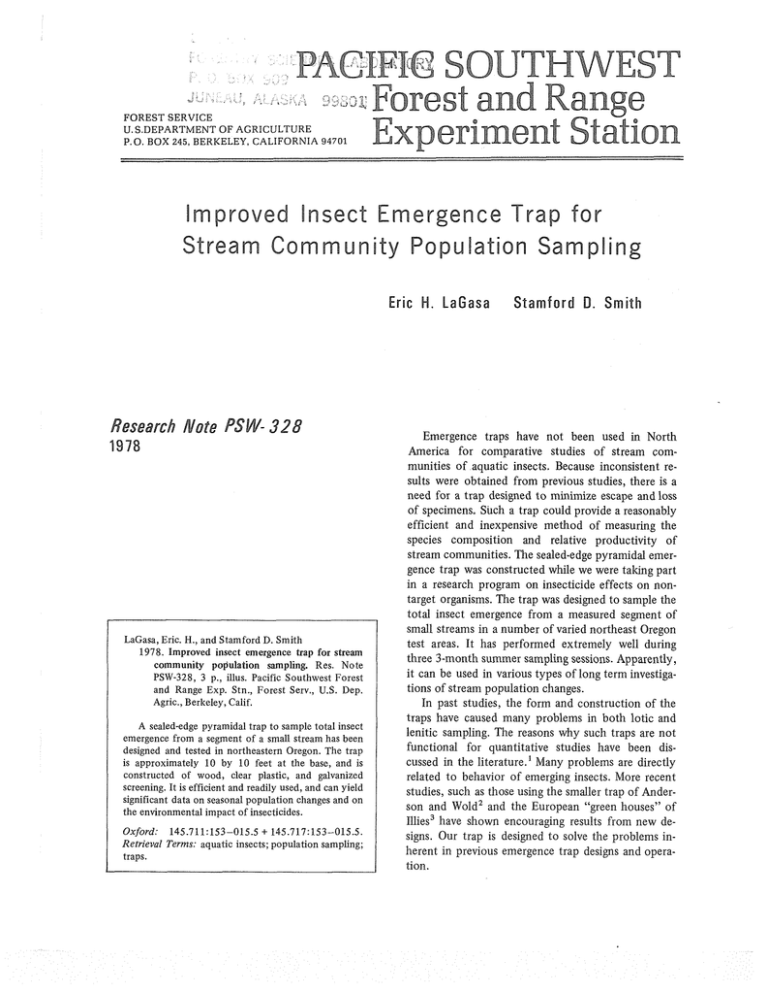Ra S and SOUTHWEST
advertisement

SOUTHWEST rest and Ra Experiment S @ FOREST SERVICE U.S.DEPARTMENT OF AGRICULTURE P . 0 . BOX 245, BERKELEY, CALIFORNIA 94701 Improved nsect Emergence Trap for Stream Community Popu ation Sampling Eric H. LaGasa Research Note PSW- 328 1978 LaGasa, Eric. H., and Stamford D. Smith 1978. Improved insect emergence trap for stream community population sampling. Res. Note PSW-328, 3 p., illus. Pacific Southwest Forest and Range Exp. Stn., Forest Serv., U.S. Dep. Agric., Berkeley, Calif. A sealed-edge pyramidal trap to sample total insect emergence from a segment of a small stream has been designed and tested in northeastern Oregon. The trap is approximately 10 by 10 feet at the base, and is constructed of wood, clear plastic, and galvanized screening. It is efficient and readily used, and can yield significant data on seasonal population changes and on the environmental impact of insecticides. Oxford: 145.711:153-015.5 + 145.717:153--015.5. Retrieval Terms: aquatic insects; population sampling; traps. Stamford D. Smith Emergence traps have not been used in North America for comparative studies of stream communities of aquatic insects. Because inconsistent results were obtained from previous studies, there is a need for a trap designed t o minimize escape and loss of specimens, Such a trap could provide a reasonably efficient and inexpensive method of measuring the species composition and relative productivity of stream communities. The sealed-edge pyramidal emergence trap was constructed while we were talung part in a research program on insecticide effects on nontarget organisms. The trap was designed to sample the total insect emergence from a measured segment of small streams in a number of varied northeast Oregon test areas. It has performed extremely well during three 3-month summer sampling sessions. Apparently, it can be used in various types of long term investigations of stream population changes. In past studies, the form and construction of the traps have caused many problems in both lotic and lenitic sampling. The reasons why such traps are not functional for quantitative studies have been discussed in the literature.' Many problems are directly related t o behavior of emerging insects. More recent studies, such as those using the smaller trap of Anderson and Wold2 and the European "green houses" of Illies3 have shown encouraging results from new designs. Our trap is designed to solve the problems inherent in previous emergence trap designs and operation. MATEWIALS AND CBNSTRUCTH<)N The trap is a modified A-frame (fig. 1A). It differs from earlier traps in that the side walls extend downward to remain in contact with the water surface or the shore, thus forming a structure which completely encloses a segment of creek. The trap measures 10 by 10 feet at the base. Crossstream supports vary according to differences in stream width. The trap is anchored on our test plots Figure l -This sealed-edge pyramidal trap was tested i n sampling,of insect emergence o n a small stream i n northeastern Oregon. I n A, the emergence trap is shown i n position over the creek; B is an exploded view o f the trap parts. t o fixed wooden beams (6 by 8 inches by 10 feet) that parallel the stream. The fixed beam bases, although not required, provide greater strength and stability for the trap and allow easy removal of the traps (to avoid winter snow damage), as well as exact relocation. Thus sites can be more easily sampled during successive years, assuming the stream does not change course. The trap superstructure is a simple A-frame formed from prefabricated triangular end panels connected at the top by a short key piece (fig. IIW). Four upright supports complete the basic framework. The end panels and the rest o f the trap are covered with alternating sections of clear plastic and galvanized window screening. T o collect the insects, the investigator enters through a hinged door at one side of the trap; a plank walkway permits him t o move about inside the trap without disturbing the creek bottom. The upstream and downstream edges of the trap are extended downward by means of screening which remains in contact with the water surface. Wltere greater fluctuation of stream level occurred, an additional flap of plastic sheeting was attached a t the bottom of the screen, and this, by floating on the water surface, effectively sealed the sample area. By using large traps we hoped t o allow room for insect movement and reduce losses of insects back into the water. During trap cleanout only a few individuals were seen t o fall back into the water. We tried t o further reduce those losses by using clear plastic catch sheets suspended horizontally across the middle of the traps. The catch sheet served t o concentrate the insects somewhat in the upper area of the trap as well as t o catch individuals that weaken and fall from the trap walls. Our initial observations of trapped insects and counts of insects found dead on the catch sheets showed that specimens apparently survive well in the traps. Although for best results the trapped insects should be removed daily, if necessary they may be allowed t o accumulate for a few days without substantial loss or deterioration of specimens. From time to time, large numbers of specimens appeared in the trap. T o aid in removing them, we adapted a small car vacuum for field use.4 The vacuum, with a small-engine 12-volt battery as power supply, collected the insects into a cloth bag connected t o the nozzle. T!re bag and nozzle assen~bly was then easily closed, removed from the vacuum and placed in a tightly fitting cyanide container. Tile vacuum made quick and accurate work of the removal process and did not appreciably damage specimens. Our study in northeastern Oregon employed nine emergence traps on seven creeks. Preliminary analysis of the great quantities of emergence data collected have proven quite interesting. The Trichoptera and Ephemeroptera were separated for detailed study, and 37 and 41 species, respectively, were identified from the various creeks. In addition t o collecting emergence data, cooperating researchers took drift and bottom san~plesduring both years. Ten-minute samples of drifting insects were taken over 24-hour periods at various times during both summers. Bottom samples were taken with a Surber sampler on the same days as the drift sanlples. Preliminary statistical analysis of the many thousands of emergent insects collected showed relative uniformity of all sites and also provided data on possible pesticide effects. A third year of samples is needed before conclusions can be drawn. We can see, however, that seasonal data are readily available froin this type of emergence trap. After 2 years of field testing, we conclude that the performance of this trap is comparable or superior t o that of other methods currently in use. Acicr~owledgmcnt: Tile work leading t o this publication was funded under grant 7 from the U.S. Department of' Agriculture's Expanded Douglas-fir Tussock Moth Resesrch and Development Program, which is administered by the Pacific Northwest Forest and Range Experiment Station, Portland, Oregon. ' NOTES (;lcdtiill, T . 1960. Tlie Epliemeroptera, Plecoptera, and Trickoptcra caught h.v emergerice traps in f wo streams during t/ieJ1earof'1958. Ilydrobiologia 15:179-88. Kimcrlc, R . A,, and N. H . Anderson. 1967. E~jaluatiot~ of aquatic insect emergence traps. J. Ikon. Ilntomol. 60: 1255-9. Mackcrcth, Jean. 1957. Notes o n Plecoptera from a stotiv stream. J . Animal I<col. 26:243-5 1. Sprulcs, Wm. M. 1947. A n ecolo~ical irivestigatiorl 0.f stream irisects it7 Algonquin Park, O~rtario. Univ. Toronto Stud. Biol. 56:l-81. Anderson, N. II., and Janet Wold. 1972. Emergefice trap collectiorzs of' Trichoptera from an Oregon stream. Can. ltntomoi. 104: 189-201. "Ilics, Joachim. 1971. 1:'Niergenz 1969 it71 Breitctihaclr. Arch. 1-lydrobiol. 69(1):14-59. Son Aire Auto lland Vacuuin Cleaner, Model IIV-95. Trade namcs and co~limercialenterprises or products arc mentioned solely for necessary information. No cndorsemcnt by the U.S. Department of Agriculture is implied. The Authors are cooperators in the U.S. Department of bigriculture's Expanded Douglas-fir Tussock Moth Research and Development Program. ERIC H. LaGASA is a research assistant in biology at Central Washington University, Ellensburg, where he earned a bachelor's degree in biology in 1971. STAMFORD D. SMITH is an associate professor at Central Washington University. He holds a bachelor's degree in Entomology from San Jose State College, California (1961) and master's and doctor's degrees from the University of Idaho, Moscow (1964, 1967). He was on assignment to the Pacific Southwest Forest and' Range Experiment Station at the time of the study reported in this publication. The Forest Service of the U.S. D e p a ~ m e n tof Agriculture . . . Conducts forest and range research at more than 75 locations from Puerto Rico to Alaska and Hawaii. . . . Participates with all State forestry agencies in cooperative programs to protect and improve the Nation's 395 million acres of State, local, and private forest lands. . . . Manages and protects the 187-million-acre National Forest System for sustained yield of its many products and services. The Pacific Southwest Forest and Range Experiment Station represents the research branch of the Forest Service in California and Hawaii.







